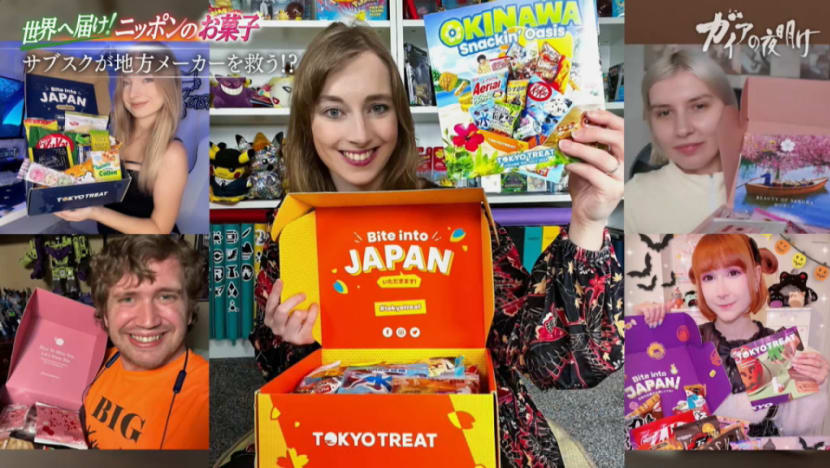Gaia Series 73: Deliver to the world! Japanese sweets
Japanese sweets connect tradition and innovation in this episode, highlighting how confectionery is helping local communities by sharing its flavours worldwide.


This audio is generated by an AI tool.
This week, we journey into Japan’s confectionery traditions, exploring how sweets bridge cultures and support disaster-stricken communities.
Japan’s rich confectionery heritage takes centerstage in this episode of Japan Hour, weaving together tradition, resilience, and global connections. The story opens in Osaka, where Midori Seika, a small confectionery factory with just 40 employees, crafts intricate jellies by hand. Their signature product, Chidori jelly, shaped like plovers on waves, symbolises good fortune and retails for 950 yen (S$8.20). These delicacies, prepared meticulously, have gained popularity not only in Japan but also overseas, attracting visitors from as far as New York.
“Very pretty. Very aesthetic,” comments a visitor from the United States, encapsulating the global appeal of Japanese sweets.
Midori Seika owes much of its international success to ICHIGO, a Tokyo-based company founded in 2015 with 78 employees, 70 per cent of whom are foreign nationals. Led by Ayumi Chikamoto, ICHIGO pioneered TokyoTreat, a subscription box service delivering Japanese sweets to 180 countries. Each box, with unique package designs, costs US$50 and contains 15 to 20 Japanese snacks. With vibrant packaging and exclusive flavours like regional KitKats, the service has propelled annual sales to over 4 billion yen.
This was a far cry from when the company comprised of just Chikamoto and her husband David. “We started everything by ourselves. We would normally source products from mass retailers, and when we didn't have enough, we would visit dozens of convenience stores to gather as many sweets as we could,” Chikamoto recalls. They would then do the packing till the early morning before shipping the boxes off.
Driven by a passion for sharing Japanese culture, Chikamoto reflects, “Japanese manufacturers are incredibly quick at launching products with various variations. Offering them as subscriptions allows people to enjoy them long-term as part of Japanese food culture.”
ICHIGO’s mission goes beyond commerce, it is also providing a much-needed sales channel for manufacturers in Japanese regions such as Wajima and Noto that have been devastated by earthquakes and floods. A case in point is Ishikawa Prefecture, where natural disasters have left communities struggling. Inspired by her own experience surviving the 1995 Hanshin-Awaji Earthquake, Chikamoto incorporates products from local manufacturers into her boxes to aid their recovery.
In Wajima City, Chikamoto visits Eisendo, a 150-year-old rice cracker shop that resumed production just months after an earthquake. President Osamu Nakamori and his son Kotaro show their flagship sesame crackers, a staple at the Wajima Morning Market. Made from potato starch, it has a subtle sweetness and has been sold at the local morning market stalls for over half a century. “The packaging [an image of a girl in a kimono] gives a traditional Japanese feel, which overseas customers love,” notes Chikamoto.
Further north in Noto Town, Chikamoto meets Yokoi Shoten, a 150-year-old candy maker famous for Matsunami candy, crafted without sugar but with rice and barley instead. Owner Chishikichi Yokoi considered shuttering after the earthquake cracked his kiln but decided to repair it within a month to preserve the cherished flavour of the sweet treat.
“I was truly amazed at how rice can become this sweet,” remarks Chikamoto, adding that such traditional craftsmanship would surprise overseas customers.
The episode highlights these artisans’ resilience in rebuilding businesses and confidence. Despite setbacks from record rainfall causing floods and landslides, Yokoi Shoten continues production, preparing Kaga Shizuku candies using premium pear puree from Ishikawa. Meanwhile, Eisendo restarts rice cracker production, dreaming of selling again at Wajima’s Morning Market. Kotaro expresses hope, “I’d be really happy if the day comes when we can sell them at Asaichi Market.” All these were made possible only with ICHIGO giving these businesses big enough orders that could help them resume their production.
As sweets from Ishikawa are packed for international shipment, Chikamoto shares her vision: “I really want people to visit Noto and enjoy freshly made sweets.” Each box includes a magazine introducing local manufacturers and tourist spots, fostering cultural exchange.
In Los Angeles, Diana, a TokyoTreat subscriber for a year and a half now, unboxes her delivery. She is an anime fan who was inspired by the sweets they eat in the comics and decided to try out TokyoTreat. She is visibly enthralled by the packaging and flavours and remarks: “It’s really cute… I always try to be careful opening it because I love the art.”
The episode closes with optimism as Yokoi Shoten and Eisendo continue operations despite adversity. Hiroki, Yokoi’s son, embraces his role in preserving the family business, inspired by Chikamoto’s vision and orders. “It feels like I’m finally starting to grasp various opportunities,” he says, reflecting on his growth.
Through sweets, this episode demonstrates how tradition and innovation unite to revive communities, celebrate heritage, and connect Japan to the world.












